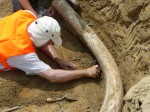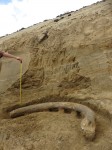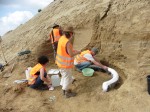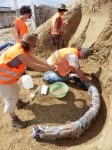 A team of paleontologists from Vienna’s Natural History Museum (NHM) has unearthed two large tusks and some vertebrae from a rare mammoth at a site 30 miles north of Vienna in the Weinviertel region of Lower Austria. The fossils were first discovered in mid-August by geologists surveying the site of a highway construction. They were studying the sediment layers when one of the geologists spotted an anomaly that turned out to be the tip of a tusk. The next day, experts from the NHM’s Geology and Palaeontology Department were called in to excavate the find and quickly unearthed a whole tusk and several vertebrae.
A team of paleontologists from Vienna’s Natural History Museum (NHM) has unearthed two large tusks and some vertebrae from a rare mammoth at a site 30 miles north of Vienna in the Weinviertel region of Lower Austria. The fossils were first discovered in mid-August by geologists surveying the site of a highway construction. They were studying the sediment layers when one of the geologists spotted an anomaly that turned out to be the tip of a tusk. The next day, experts from the NHM’s Geology and Palaeontology Department were called in to excavate the find and quickly unearthed a whole tusk and several vertebrae.
They knew there was more to be found, but rain interfered with further exploration for a few days. The delay made researchers antsy since this is a construction site and they didn’t have much time to salvage whatever was there. As soon as the rain let up, they went back to digging and unearthed a second tusk. The tusks are about 2.6 meters (8.5 feet) long now and were probably three meters (9.8 feet) long when they were still attached to their owner.
 NHM paleontologists believe the tusks and vertebrae came from a single animal who died in the proto-Zaya river. The shape of the tusks and the sediment layer in which they were found suggest a preliminary date of around one million years ago. The fact that there was a river in which a mammoth’s remains could become embedded in the mud indicates it lived during an interglacial period, of which there were many during the 2.5 million years of the Pleistocene.
NHM paleontologists believe the tusks and vertebrae came from a single animal who died in the proto-Zaya river. The shape of the tusks and the sediment layer in which they were found suggest a preliminary date of around one million years ago. The fact that there was a river in which a mammoth’s remains could become embedded in the mud indicates it lived during an interglacial period, of which there were many during the 2.5 million years of the Pleistocene.
The museum’s press release doesn’t name the possible species, referring to it solely as Ur-mammoth, meaning original or primitive mammoth. Maybe the steppe mammoth (Mammuthus trogontherii) which ranged over Eurasia during the Pleistocene? Its ancestor the southern mammoth (Mammuthus meridionalis) died out 1.5 million years ago, so if the provisional dating estimate proves accurate, the steppe mammoth seems the  most likely candidate. The descendents of a Siberian population of steppe mammoths evolved into the woolly mammoth about 400,000 years ago, so that might earn it the ur. Also the curved tusks seems most similar to those of Mammuthus trogontherii, to my entirely inexpert eyes.
most likely candidate. The descendents of a Siberian population of steppe mammoths evolved into the woolly mammoth about 400,000 years ago, so that might earn it the ur. Also the curved tusks seems most similar to those of Mammuthus trogontherii, to my entirely inexpert eyes.
After they were fully excavated, the tusks were stabilized for transport with the application of a thin coat of plaster bandages and wrapped with damp newspaper. They were then brought to the Natural History Museum in Vienna where they will be conserved and prepared for  further study. Researchers are excited to find out all they can, not just about the animal but its environment. Very few remains this old have been discovered in Austria, so there is much to be learned from them and the discovery context.
further study. Researchers are excited to find out all they can, not just about the animal but its environment. Very few remains this old have been discovered in Austria, so there is much to be learned from them and the discovery context.
The museum will keep the remains, but tt’s not known at this juncture whether the tusks and vertebrae will be integrated into the museum’s permanent exhibition. They will be very briefly shown at the a “Behind the Scenes” event at 11:00 AM on November 6th.
The method of dating seems magnificently vague.
It is, but this was a salvage project and they had to dig on the quick. Perhaps they’ll find some samples from the layers that can be absolutely dated.
Are there estimates of the size (height, length, weight) of a mammoth with 10 foot tusks?
Bones have been found of steppe mammoths that are 13-15 feet tall at the shoulder for an estimated weight of 9-15 metric tons. Tusks could get as large as 17 feet long. What a fine beast it was.
that must bring more than dollar under your pillow
There’s a regular mammoth rush going on in Siberia as I type this. Miners there are using water cannons to blast away soil where there are known deposits of mammoth remains to sell on the Asian ivory market.
The bottom has dropped out of the oil market. I guess Putin needs the spare cash?